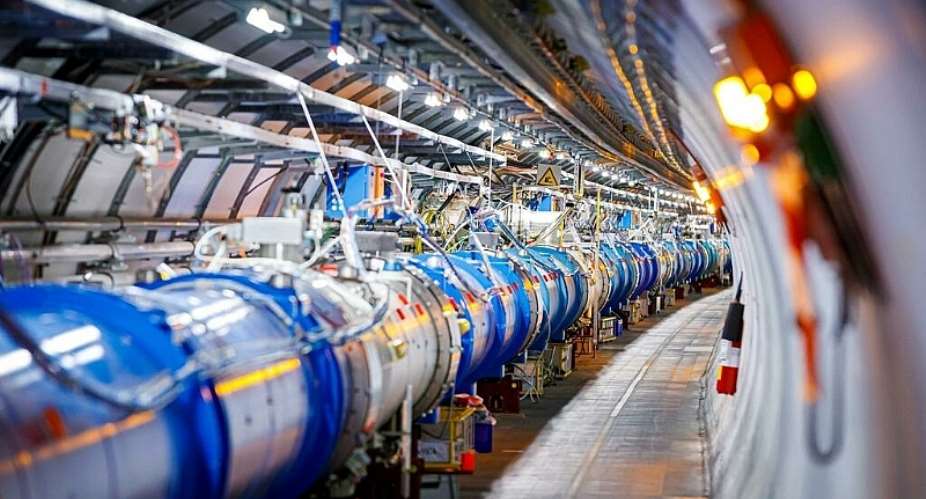Ten years after it helped reveal the existence of the particle known as the Higgs boson, the Large Hadron Collider is about to start smashing protons into one another at unprecedented energy levels in its quest to understand how the universe works.
The world's most powerful particle collider started warming up in April after a three-year break for upgrades.
From Tuesday it will run around the clock for nearly four years at a record energy of 13.6 trillion electronvolts, according to the European Organisation for Nuclear Research (CERN).
For the technically minded, an electronvolt is the amount of kinetic energy gained or lost by a single electron accelerating from rest through an electric potential difference of one volt in a vacuum. One electronvolt is equal to 1.602176634×10−19 J. It will not keep your fridge turning over, nor light your lamps.
The Large Hadron Collider (LHC) will send two beams of protons – particles found in the nucleus of an atom – in opposite directions at nearly the speed of light around a 27 kilometre ring buried 100 metres under the Swiss-French border.
The resulting collisions will be recorded on special film and analysed by thousands of scientists in the on-going effort to probe dark matter, dark energy and other fundamental physical mysteries.
Is Higgs the only boson?
The higher energy of the upgraded collider will allow rersearchers to further investigate the Higgs boson, which the Large Hadron Collider first revealed in 2012.
The discovery revolutionised physics, partly because the boson confirmed current mainstream theory, the so-called Standard Model, which explains the fundamental particles that make up matter and the forces that govern them.
Several recent findings have, however, raised questions about the Standard Model. Against that background, the newly upgraded collider will look at the Higgs boson in more detail.
"The Higgs boson is related to some of the most profound open questions in fundamental physics today," said CERN director-general Fabiola Gianotti.
Joachim Mnich, CERN's head of research and computing, said there was still much more to learn about the boson.
"Is the Higgs boson really a fundamental particle or is it a composite?" he asked.
"Is it the only Higgs-like particle that exists – or are there others?"
Pass me a tetraquark
Past experiments have determined the mass of the Higgs boson, as well as more than 60 composite particles predicted by the Standard Model, such as the tetraquark.
Gian Giudice, head of CERN's theoretical physics department, said observing particles is only part of the job.
"Particle physics does not simply want to understand the how – our goal is to understand the why," he said.
Among the Large Hadron Collider's nine experiments is ALICE, which probes the matter that existed in the first 10 microseconds after the Big Bang, and LHCf, which uses the collisions to simulate cosmic rays.
After this four-year run, the collider will come back in 2029 as the High-Luminosity LHC, increasing the number of detectable events by a factor of 10.
Beyond that, scientists are already planning a Future Circular Collider – a 100 kilometre magnetic ring that will reach energies of 100 trillion electronvolts, seven times more powerful than the LHC.
And still no use to your fridge.





 Dumsor: Don't rush to demand timetable; the problem may be temporary — Atik Moha...
Dumsor: Don't rush to demand timetable; the problem may be temporary — Atik Moha...
 Space X Starlink’s satellite broadband approved in Ghana — NCA
Space X Starlink’s satellite broadband approved in Ghana — NCA
 2024 election will be decided on the grounds of the economy; choice of running m...
2024 election will be decided on the grounds of the economy; choice of running m...
 Dumsor: We're demanding less; just give us a timetable — Kwesi Pratt to ECG
Dumsor: We're demanding less; just give us a timetable — Kwesi Pratt to ECG
 Do I have to apologise for doing my security work, I won’t – Simon Osei-Mensah r...
Do I have to apologise for doing my security work, I won’t – Simon Osei-Mensah r...
 All my businesses have collapsed under Akufo-Addo — NDC Central regional chair
All my businesses have collapsed under Akufo-Addo — NDC Central regional chair
 Military, Prison Officers clash in Bawku, three injured
Military, Prison Officers clash in Bawku, three injured
 GRA-SML contract: MFWA files RTI request demanding KPMG report
GRA-SML contract: MFWA files RTI request demanding KPMG report
 Court threatens to call second accused to testify if NDC's Ofosu Ampofo fails to...
Court threatens to call second accused to testify if NDC's Ofosu Ampofo fails to...
 Family accuses hospital of medical negligence, extortion in death of 17-year-old...
Family accuses hospital of medical negligence, extortion in death of 17-year-old...
